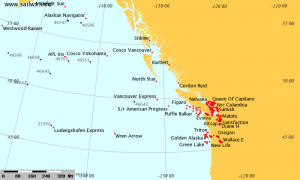
Howard Frazer Chamberlin was on Nootka lighthouse in 1942 according to the interview by the Naval Reserve (see letters at left). But there is a problem here.
When I received a copy of this letter I thought it was referring to the attack on Estevan Point which supposedly helped introduce conscription in Canada during the Second World War. But if you check the dates, this seems to have occured almost a month later to the day that the Estevan Point shelling happened. According to all records, the shelling of Estevan Point took place nightfall of June 20, 1942.

This letter seems to show that there was another attack at Nootka lighthouse about a month later on the evening of July 18, 1942. In fact the lightkeeper states that he phoned Estevan Point Wireless station to see if they were being plastered again! (my emphasis – JC) But Estevan returned the call and said that they had heard nothing so it must have been nearer Nootka. From working with explosives in mining and prospecting, Howard Chamberlin knew the difference between industrial explosives and high-explosives.
The only thing that appears to be at odds here is that he feels the vibration from the explosions as from underwater. I wonder if he was hearing depth charges going off? This is just one month later than the Estevan incident. I will bet that the Navy and the Naval Reserve were on high alert during this time and expecting the worse. Perhaps a floating log triggered the release of a few depth charges.
A transcript of the original letter(s) follows:
From H.M.C.S. “Pryer”
To COAV
Esquimalt BC
Nootka Lighthouse
2200 / 19 / 7 / 42
Subject
Interview With Mr. H. F. Chamberlin, LightkeeperI was sitting in the kitchen of the Light
house, overlooking the sea, and having
a cup of Tea at 1902 hours July 18/42, when
I both felt and heard an explosion from
a southerly direction. (out to sea) and
this was followed by six other shocks
at intervals of about one (1) minute
between shocks.
I was naturally surprised and could
see the vibrations from the shocks in
the cup of Tea.
As an old Miner and Prospector I can
easily tell the difference between “blasting”
and “submarine” shocks, and the shock
I both heard and felt were definitely from
seaward, and from the “feel” of the vibration
I would say from underwater.
The first shock occured at 1902 and the
last shock at 1911, as I noted the time of last shock.
I phoned the wireless station at Estevan Point
and asked them if they had been “plastered” again, and
they informed me that they had felt or heard nothing.
It was at 1915 when I phoned Estevan Pt. Wireless.Page 2
(same as Page 1 but with signature at bottom)Witness
Chief Skipper J. D. McPhee, R.C.N.R.
Commanding Officer
H.M.C.S. “Pryer”
*********************************
– Howard F. Chamberlin (Lightkeeper on Nootka 1936 – 1941)








